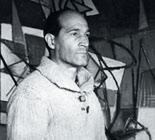
Initially a member of the influential “Abstraction-Creation” group during the 1930’s, Jean Villeri became established amongst the leading abstract painters of the École de Paris. The son of an Italian composer and conductor of the Monte Carlo orchestra, Villeri started studying painting, aged 17, while living on the Cote d’Azur where the brightness and clarity of the light has famously attracted artists from around the world. He began showing in the regional Salons of Menton and Nice; at this time he met Soutine, Osterling and the elderly Renoir. He assiduously visited museums and travelled regularly to Italy. In 1922 he married and settled in Le Cannet.
Villeri held his first exhibition in Paris at Galerie Allard in 1924, followed by further shows in Nice, Cannes and Le Cannet in the next few years. By the end of the 1920’s he was becoming established and was invited to participate in the influential Abstraction-Création movement with August Herbin, Kandinsky, Mondrian amongst others, with whom he exhibited during the 1930’s. The war years left little time for painting but after the Liberation in 1944 the avant-garde soon re-grouped with a new conviction about their work. One of the most significant declarations of this new spirit was an exhibition at Galerie Maeght in 1948 in which Villeri exhibited alongside Soulages, Hartung, Lanskoy, and Schneider. From this point Villeri’s reputation began to develop internationally beginning with the group show “French Abstract Painting” which travelled around Germany, then Amsterdam and America in 1948. As well as international shows in Stockholm, Milan and Helsinki, he exhibited in the Paris Salon des Réalités Nouvelles in 1948, 1949, 1956 and 1971; in the Salon de Mai in 1948, and from 1952-58; and in the Salon des Tuileries in 1950. He participated in the Biennale de Menton in 1951, won a silver medal there in 1953 and a gold medal in 1955. In 1977 he exhibited in the “Abstraction Création” retrospective at the Musée d’Art Moderne in Paris, and more recent individual retrospectives of the artist’s work have been held at the Musée des Beaux-Arts de Nice, 1988; the Centre International d’Art Contemporain, Carros, 1999; the Chateau Musée, Cagnes sur Mer, 2002; and at the Museo Civico in Sanremo, Italy in 2003.
The artist’s work can now be found in many museum collections including the Bibliotheque National, Paris; Fonds National d’Art Contemporain, Paris; Musée Picasso, Antibes; Musée d’Art Moderne et Contemporain, Nice; Chateau Musée, Cagnes-sur-Mer; Fondation Zervos, Vezelay.